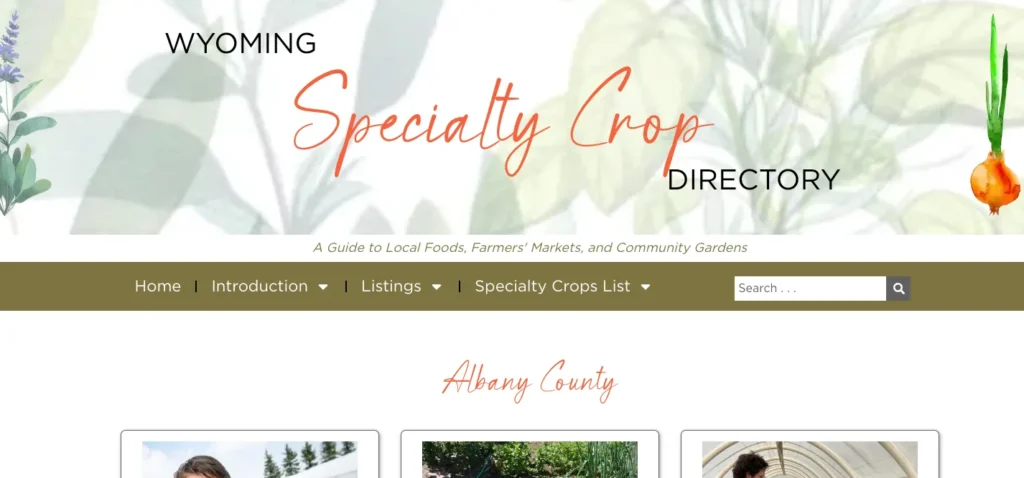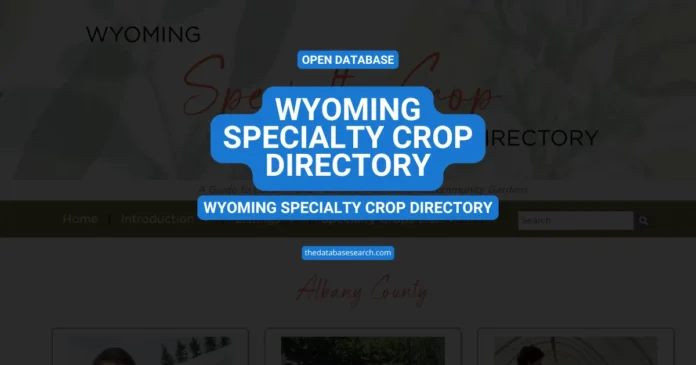The Wyoming Specialty Crop Directory should not be considered a flashy app or a farm-to-table trend piece. It is a straightforward yet effective digital tool that connects consumers (including institutional buyers) and researchers to small-scale producers found throughout the state. This public directory opens up access to Wyoming’s less visible agricultural diversity, including safflower, squash, honey, and hops, one farm at a time.
This guide will explain what the directory is and how it works, the types of individuals who utilize it, and why it is more significant than you might imagine, especially given the state’s low population density, short growing season, and often, isolated small producers.
What Is the Wyoming Specialty Crop Directory?
The Wyoming Specialty Crop Directory is a publicly available, online database established by the University of Wyoming Extension, financed by the USDA Specialty Crop Block Grant Program. Its aim is direct: to enhance visibility and market access for “specialty crops” producers statewide.
But what exactly qualifies as a specialty crop?
What Counts as a Specialty Crop?
According to the USDA definition, specialty crops include:
- Fruits and vegetables (e.g., tomatoes, apples, cucumbers)
- Tree nuts (e.g., walnuts, pecans)
- Culinary herbs and spices (e.g., basil, mint)
- Nursery, floriculture, and horticultural plants
Crops such as wheat, corn, or barley—which disproportionately represent commodity agriculture—are expressly excluded. Similarly, livestock products (meat, dairy, eggs) are excluded. This is a critical distinction: the purpose of the database is not to focus on industrial agriculture, it is about small-to-medium sized diversified agricultural systems operating at the local level.
Who Uses the Wyoming Specialty Crop Directory—and Why It Matters
This is not just a feel-good tool for “buying local.” The Wyoming Specialty Crop Directory serves several critical audiences, each with different needs:
For Consumers: Local Food Without the Farmers’ Market Guesswork
Want to find garlic scapes, native berries, or pesticide-free apples in your area? The database allows anyone to search by:
- County
- Specific crop
- Certification (organic, GAP)
- Sustainable practices (e.g., “chemical-free,” “no-till”)
🔍 Example:
A family in Natrona County wants to source local honey and seasonal greens. A quick search in the directory reveals four producers within 50 miles, including contact information and notes on their farming practices.
For Institutions: Sourcing for Schools, Hospitals, and Programs
The directory also serves as a sourcing tool for institutional buyers like:
- School lunch programs
- Hospital food services
- State-funded food distribution efforts
This is especially beneficial as part of the USDA Local Food Purchase Assistance Cooperative Agreement, which supports governing and non-profit institutions purchasing from local, underserved producers. Having a centralized directory makes this manageable without having to sift through an old PDF or social media page.
For Researchers & Policymakers: A Map of Agricultural Resilience
Food systems analysts, agricultural researchers, and county officials can use the directory to:
- Identify underserved regions
- Track specialty crop diversity by region
- Monitor changes in local food access over time
In the context of Wyoming’s growing interest in food sovereignty and regional self-reliance, this directory functions as a decentralized infrastructure map.
How the Wyoming Specialty Crop Directory Works: A Closer Look
Let’s get technical. The Wyoming Specialty Crop Directory is not a dynamic marketplace or ordering platform—it’s a searchable directory. But it’s surprisingly rich in metadata.
Search Features and Filters
Visitors can filter producers by:
- County
- Crop type (searchable by keyword)
- Organic or GAP certifications
- Farming methods (e.g., pesticide-free, hydroponic, hoop house)

Source: wyoextension.org/specialty-crop/
What’s in a Producer Profile?
Each profile typically includes:
- Producer name and business
- Address and county
- Crop types and farm products
- Certifications held (USDA Organic, GAP)
- Notes on sustainability practices
This gives the end user a clear picture—not just of what is produced, but how.
Data Integrity and Limitations
Here’s where critical thinking comes in. The data is self-reported by producers through a submission form. While that ensures speed and reach, it introduces some issues:
- No guarantee of accuracy
- No regular third-party verification
- Some profiles may be outdated or incomplete
It’s a tradeoff between accessibility and accountability.
The Wyoming Specialty Crop Directory: A Quiet but Critical Infrastructure for Local Food Economy
At first glance, this may look like a humble spreadsheet in website form. But scale matters.
1,100+ Producers—and Counting
According to recent reporting from Oil City News, the database lists over 1,100 specialty crop producers—a remarkable number considering Wyoming’s population is under 600,000.
That means there’s approximately one specialty crop producer for every 500 residents. In rural counties, that can make the difference between access and scarcity.
Not All Organic, But Many Go Beyond
It’s worth noting: not all listed producers are certified organic. Many use terms like:
- “Chemical-free”
- “Natural practices”
- “Low-till” or “no-till”
This makes it essential for users to read profiles carefully and follow up with direct contact. Unlike the Organic Integrity Database, this tool is not regulatory—it’s informational.
Limitations, Gaps, and Ethical Questions About the Wyoming Specialty Crop Directory
Every public database has tradeoffs. This one is no exception.
Voluntary Participation = Incomplete Coverage
Producers must opt in to be listed. That means:
- Some local growers may be missing entirely
- Smaller operations may avoid listing for privacy reasons
- New producers may take months to appear
No Pricing or Seasonal Data
Unlike CSA platforms or digital marketplaces, the directory does not provide:
- Product availability by month
- Harvest timelines
- Real-time pricing
For that, users must reach out to producers directly.
Should All Farms Be Publicly Searchable?
Some producers, especially those operating on private land or with limited capacity, may be reluctant to be “on the map.” This raises ethical questions about visibility vs. privacy—especially in rural, tightly-knit communities.
Practical Tips: How to Use the Wyoming Specialty Crop Directory Effectively
Here’s how to make the most of the tool:
- Start with your county → Use that as a base, then explore adjacent regions.
- Don’t assume “natural” means certified organic → Look for third-party verification or clarification in the profile.
- Contact producers directly → Email or call to confirm availability before visiting.
- Use it as a seasonal planning tool → Even if availability isn’t listed, knowing who grows asparagus or saffron locally helps you plan meals or programs.
Conclusion: A Simple Tool With Deeper Implications
The Wyoming Specialty Crop Directory isn’t trying to be the next Amazon Fresh or Instacart. It doesn’t sell. It connects. It’s a map, not a market—and that distinction matters.
In a world that increasingly leans on short supply chains, local food resiliency, and regional identity, this quiet little directory becomes more than a web tool. It becomes a digital backbone for small agriculture in one of America’s least populated—but most ruggedly independent—states.
Sources & References
- Wyoming Specialty Crop Directory: https://wyoextension.org/specialty-crop/
- University of Wyoming Extension Publication MP-150: https://www.wyoextension.org/publications/Search_Details.php?pubid=2081&pub=MP-150
- Oil City News (2025-10-20): New Online Database Connects Wyoming Consumers to Local Food Producers
- USDA Specialty Crop Block Grant Program: https://www.ams.usda.gov/services/grants/scbgp
- USDA Organic Certification Program: https://www.ams.usda.gov/rules-regulations/organic
- Guide to the Organic Integrity Database – TheDatabaseSearch.com
- Chemical Contaminants Transparency Tool Guide – TheDatabaseSearch.com


